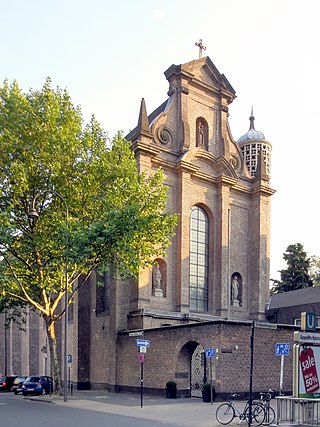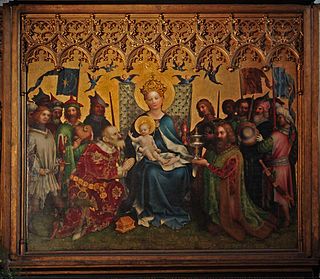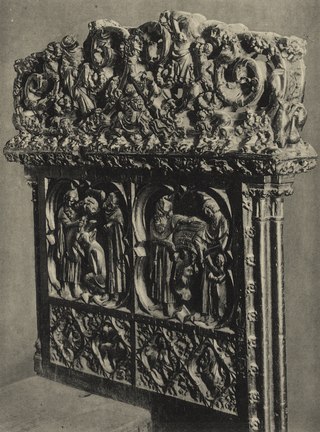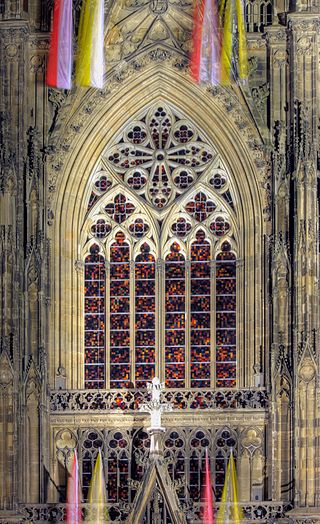
Rodenkirchen is a southern borough (Stadtbezirk) of Cologne (Köln) in Germany. It has about 110,000 inhabitants and covers an area of 54.55 square kilometres. The borough includes the quarters Bayenthal, Godorf, Hahnwald, Immendorf, Marienburg, Meschenich, Raderberg, Raderthal, Rodenkirchen, Sürth, Rondorf, Weiß and Zollstock.
The twelve Romanesque churches of Cologne are twelve landmark churches in the Old town (Altstadt) of Cologne, Germany. All twelve churches are Catholic.

The Cologne Public Library is among the biggest and most important public libraries in Germany. The central library is part of the 'Kulturquartier' near the Neumarkt. It is located at the Josef-Haubrich-Hof, with the new Rautenstrauch-Joest-Museum in its immediate neighbourhood. Since 2008, Dr. Hannelore Vogt has been the director of the library.
Centrum Schwule Geschichte e. V., abbreviated CSG, is a German "LGBT" organization based in Cologne (Köln).

The Basilica of the Holy Apostles is a Romanesque church in Cologne (Köln), located near Innenstadt's busy Neumarkt (Köln). The former collegiate church is dedicated to the twelve Apostles. It is one of the twelve Romanesque churches built in Cologne in that period.

St. Maria in der Kupfergasse is a Baroque church in Cologne, western Germany, in the district of Innenstadt. The pilgrimage church is dedicated to St. Mary, the Black Madonna. It was completed in 1715 and measures 37.20 meters in length and 17.30 metres in width.
Studie II is an electronic music composition by Karlheinz Stockhausen from the year 1954 and, together with his Studie I, comprises his work number ("opus") 3. It is serially organized on all musical levels and was the first published score of electronic music.

The Tauzieher is a limestone sculpture by Nikolaus Friedrich which was erected in 1911 in Rheinauhafen, Cologne. It depicts a man making a heavy rope or hawser fast to a bollard and is 6.5 metres in height. In 1980, it was listed as one of the first heritage sites in Cologne.

The term Cologne School of Painting was first applied in the 19th century to describe old German paintings generally. It subsequently came to refer more specifically to painters who had their workshops in medieval Cologne and the lower-Rhine region from about 1300 to 1550.

TheJudensau at the choir stalls of Cologne Cathedral is a medieval, antisemitic wood carving at the side of one of the seats in the choir of Cologne Cathedral. It was produced between 1308 and 1311. It shows a Jews' sow, a folk art image of Jews in obscene contact with a large female pig, which in Judaism is an unclean animal. It is one of the oldest representations of this theme. Directly beside is another antisemitic motif, which is generally interpreted as an illustration of the blood libel legend. This combination is only known from one other case, a painting from the 15th century at the Old Bridge in Frankfurt.

The Cologne Cathedral Window is the stained glass window in the south transept of the Cologne Cathedral designed by Cologne artist Gerhard Richter. On a surface of 106 square metres 11.263 glass squares in 72 colours of 9,6 cm × 9.6 cm were principally arranged randomly, with others selected in response to architectural context. The window was inaugurated on 25 August 2007 as part of a Eucharistic celebration; the abstract execution was both celebrated and strongly criticized.

Stefan Kaiser is a German sculptor.

The Förderverein Romanische Kirchen Köln e. V. is a German association which financially and conceptually supports the research, restoration and preservation of Romanesque churches in Cologne. It was founded in 1981 and also organises public relations, guided tours and lectures to improve public awareness of these churches. Günter Heidecke was one of its founders and also acted as its chairman until 2002.
Willy Weyres was a German architect and academic teacher. He was Kölner Dombaumeister from 1944 to 1972, diocesan master builder for the Archdiocese of Cologne for more than ten years, and full professor of architectural history and monument preservation at the RWTH Aachen from 1955 until his retirement in 1972. Under his leadership, the Cologne Cathedral was restored and further developed after the Second World War.

Zollstock is a district of Cologne in the borough of Rodenkirchen. Situated west of the river Rhine, Zollstock was first mentioned in 1877 and experienced increased development from the 1880s onwards. Since 1901, the district has housed the Südfriedhof, a large monumental cemetery.

The Cologne Cathedral quarter is the area immediately surrounding Cologne Cathedral in Cologne, North Rhine-Westphalia, Germany. When the Gothic cathedral was built, it was closely surrounded by houses and smaller churches. When the cathedral was completed in 1880 as a national symbol, it was freed from adjacent structures and stood isolated, unhampered by traffic. After the inner city was destroyed in World War II, it was rebuilt, with a pedestrian area connecting to the cathedral. In 1970, the Domplatte was constructed as a large concrete surface without steps around the cathedral, which became the location of major open-air events such as Carnival and pop concerts. The design of the cathedral surroundings has remained a challenge for urban planning.

Arnold Wolff was a German architect. He was Cologne Cathedral Master Builder and head of the Dombauhütte of the Cologne Cathedral from 1972 to 1998. From 1986 to 1997, he was academic teacher for restoration and conservation at the Cologne University of Applied Sciences.

The finials of Cologne Cathedral from the tops of the two towers at a height of 149 to 157 metres. A copy of this finial in original size, but made of concrete, has stood below the steps in front of the west façade of the cathedral since 1991.
The Taubenbrunnen is a fountain sculpture designed by Ewald Mataré and erected in 1953 in the Altstadt-Nord district of Cologne, situated directly in front of the west side of the Cologne Cathedral.

Franz Julius Albertus Clouth was a German pioneer in rubber processing.















